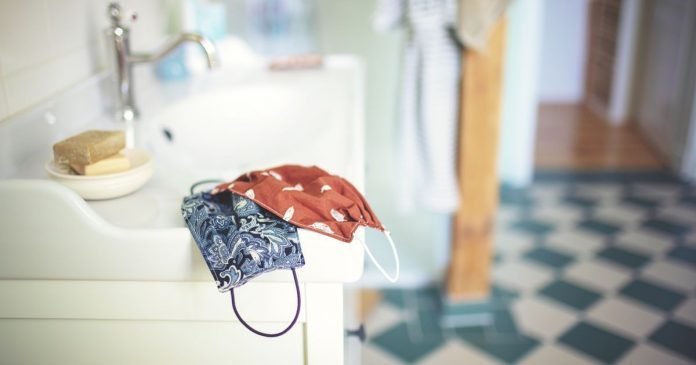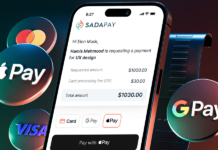With everyone scrambling to find face masks to wear, DIY tutorials are thriving on YouTube and TikTok.
Many of these videos do more than just teach you how to craft a mask out of stuff you have at home. TikTok creator and model Marc Sebastian primarily uses his Instagram platform for activism, but when he saw young people refusing to social distance, he brought his message to TikTok. In a video that now has more than 450,000 views, he sewed 25 fabric face masks to donate to a local hospital while commenting on the American government’s fumbled pandemic response to the new coronavirus.
First, he ironed out unused cotton fabric and cut it to size. Then, he narrated, he went to bed to “dream about universal healthcare and a world in which people actually practice social distancing.” The next day, he sewed elastic bands to the fabric while reminding viewers about the absurdity of the medical shortage the country faces.
“And if the fact that you’re watching a TikTok about resources being so depleted that hospitals are turning to civilians making fabric face masks doesn’t make you realize the severity of the situation, that we’re in,” he narrated before turning directly to the camera. “It should.”
Searching “DIY face mask” on YouTube yields hundreds of results; one tutorial from mommy blogger Erica Arndt has nearly 3.6 million views since it was uploaded March 21. The types of masks vary. Some include pockets so users can change out filters. Some are more rigid, and include nose wires to better shape the mask to the user’s face. Crafting channel The Q‘s tutorial makes a more complex respirator-style mask out of plastic soda bottles.
Other creators are also tailoring mask tutorials to better fit the theme of their channels, like PierreG ASMR, whose video features intimate, frisson-inducing sounds of a scissor gliding through paper towels. Historical reenactment enthusiast and seamstress Bernadette Banner used a Victorian sewing machine to put together masks for a veterinary clinic.
As the number of COVID-19 cases continues to rise — more than 1 million people people worldwide have been diagnosed with it as of Thursday — there’s still no consensus on whether people should wear face masks when they’re out in public.
The Centers for Disease Control recommended on Friday that everyone in the U.S. should wear a mask whenever they go outside. (It’s important to note that people are still being urged to stay home, practice social distancing, and wash their hands frequently.) In his daily White House briefing, meanwhile, Trump suggested that Americans could cover their faces if they wished, but he would not be doing it himself.
Prior to Friday’s instructions to cover your face, there had been an ongoing public debate about whether masks were necessary to prevent the spread of coronavirus, which is transmitted through close proximity to an infected person. A study published in the New England Journal of Medicine suggests that the virus can stay suspended in air for half an hour before settling on surfaces. As the Washington Post reports, well-fitting masks made from T-shirt fabric does prevent some droplet transmission.
But it’s not as simple as just going to the store to buy yourself a mask. With many people trying to avoid buying up precious N95 masks that healthcare workers desperately need, they’re taking precautions by making their own.
“Wearing a fabric mask is better than nothing and we are at a point where…something is better than nothing,” Sebastian told Mashable in an Instagram DM.
He noted that his donation, and thousands of others, would go to non-COVID-19 patients, veterinarians, and healthcare providers who don’t need N95 masks but do need to protect vulnerable patients. In the comments of a mask tutorial he posted a few days later, he added that the masks will go to those in need of personal protective equipment.
And for many online creators, making masks isn’t just an opportunity to make content, but to also reach out to the misinformed.
“I started out doing like a little vlog about doing the masks but it felt weird and really apocalyptic,” Sebastian said. “I added in those messages because the majority of people on TikTok are Generation Z, which are the same ones going on spring break, not social distancing, etc.”
He added that by using TikTok to post the video, instead of Instagram, he had a better chance of reaching people who otherwise wouldn’t see his content. Although TikTok’s For You Page algorithmically generates a queue of videos based on the users’ scrolling history, it also pushes content from creators they don’t follow. By landing on the coveted For You Page, Sebastian hoped to expose TikTok users to commentary about the pandemic that they might not see elsewhere.
“No conservatives look at my Instagram but they don’t have a choice if it’s showing up on their For You Page,” he explained. “[I had] to do it in a subtle way where humor was still at the forefront. To almost sugarcoat it while also making people realize the selfishness of what some of them were doing but doing it in a way where they didn’t feel truly attacked.”
In an effort to combat misinformation, TikTok itself has been adding banners to videos that are tagged with keywords like “coronavirus” and “COVID-19,” encouraging users to seek further information from reliable sources. The company also partnered with the World Health Organization (WHO) in March, bringing it on the platform as an informational resource, and donated $10 million to the WHO’s coronavirus response fund. Similarly, YouTube began adding links to the CDC and WHO on videos that mention the pandemic.
In addition to the platforms’ efforts, Sebastian hopes creators themselves will continue to make content encouraging uninformed users to know what’s going on around them. He worries that younger users will be influenced by adults who don’t realize the severity of the pandemic because of early denial from Republican leaders like Trump, who tried to downplay the coronavirus as a “Democratic hoax.”
“For TikTok, the way you present things has to be different than the way you present issues on other social media platforms,” he said. “You may not be educated enough to realize the importance of your vote but I hope that through TikTok you see the people you’re actively voting against…The political divide is what will bring us down ultimately so look around, see what you’re doing.”
Making mask tutorials is a start.











